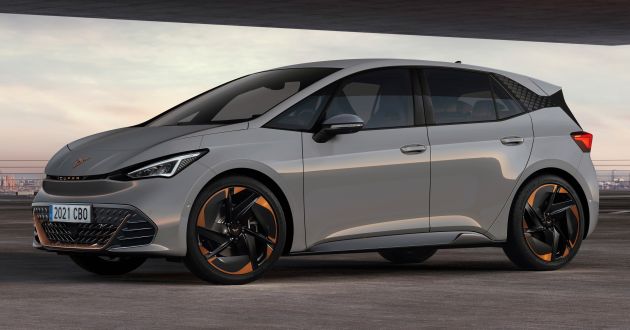Cupra, after launching a slew of aggressive, high-performance cars, has finally introduced its first fully electric vehicle. Say hello to the Cupra Born, formerly known in concept guise as the el-Born. There are four battery variants available at launch, with outputs ranging from 150 PS to 231 PS.
Designed and developed in Barcelona, the Cupra Born will enter production later this year at the Volkswagen Group’s Zwickau plant in Germany, which is the largest EV factory in Europe. The Born uses the same MEB architecture as the Volkswagen ID range, so much of its underpinnings – including the electric powertrain and battery capacity – will be familiar.
The entry-level 150 PS variant (single motor, rear-wheel driven) is fitted with a 45 kWh battery pack, offering a range of up to 340 km. Above that is the 58 kWh-equipped version (420 km of range), available in either 204 PS or 231 PS tunes. The range-topping model packs a 77 kWh battery pack (540 km of range) and an output of 231 PS. Standard torque output is 310 Nm for every variant.
In terms of performance, the 150 PS model will do the century sprint in 8.9 seconds. The 204 PS gets to 100 km/h in 7.3 seconds, whereas the 231 PS (58 kWh) model does it in 6.6 seconds. The heavier 231 PS variant with the 77 kWh battery sprints to 100 km/h in 7.0 seconds. Note that only models with 231 PS get the e-Boost performance pack, which will be introduced from 2022.
Customers can specify the dynamic chassis control system, offering four drive modes – Range, Comfort, Individual or ‘Cupra’. This enhances the driving experience, the automaker claims, allowing drivers to take further advantage of the near 50:50 weight distribution.
Now, for charging, the largest 77 kWh battery pack is the only model that can support the full 125 kW DC fast-charging rate (CCS Combo 2). This allows users to charge from 5% to 80% in approximately 35 minutes. For models equipped with the 58 kWh battery pack, the DC fast-charge rate is capped to 100 kW, while the 45 kWh battery can only be juiced at a maximum DC rate of 50 kW.


The specifications of the integrated charger has yet to be disclosed, but going by the VW Group’s standards, it will likely ship with a 11 kW AC charger (via a Type 2 connection) as standard, with the option of upgrading to a 22 kW unit. Charging the 77 kWh battery pack (from 0 to 100%) at 22 kW takes 7.5 hours, or double that if the 11 kW charger is specified.
Size-wise, the Cupra Born measures 4,322 mm long, 1,809 mm wide, 1,537 mm tall and has a wheelbase of 2,767 mm. That puts it right about the size of the ID.3 Hatch, with the Cupra being the sleeker of the two thanks to its slightly longer and less tall proportions.
On the design front, the Born continues the automaker’s sporty design language, accentuated here with the full LED headlights and copper-framed intakes. On the bonnet you’ll find the bronze Cupra badge, and the slim grille features the Cupra script that’s also finished in bronze.
Other design highlights include the aggressively raked A-pillars, door-mounted side mirrors, gloss black B-pillars, nicely textured “floating” C-pillars, large roof spoiler with integrated brake lights, full-sized panoramic glass roof (trim dependent), continuous LED tail light strip, plus an integrated rear diffuser.
Wheel sizes vary between 18 to 20 inches, with tyre width ranging from 215 mm to 235 mm. Customers have up to six colours to choose from – Vapour Grey, Glacial White, Geyser Silver, Rayleigh Red, Quasar Grey, and the exclusive Aurora Blue.
Inside, the overall design of the Born remains close to what we saw with the el-Born concept, which is quite in line with the interior design of other Cupra models. The dash layout is clean and uncluttered, with a huge 12-inch touchscreen display (1560 x 700 pixels) mounted right in the middle of the dashboard, floating style. This is standard for all models, and the display is angled towards the driver.
Cupra Connect is standard, now linked with the newly-developed My Cupra smartphone application. There’s also Apple CarPlay and Android Auto, with music piped through the optional nine-speaker Beats audio system. A Qi wireless smartphone charging tray is standard for all variants.
The flat bottom leather-wrapped steering wheel is a typical Cupra unit, as is the fully digital instrument panel. Some of the composites used to create this cabin were made from recycled plastics. Even the centre section of the bucket seats (with integrated head restraints) is made from Seaqual Yarn, derived from upcycled marine plastics. The yarn is said to have a near identical physical properties to virgin polyester.
Another recycled material used here is Dinamica microfibre, seen here on the door panels. Dinamica can be your main choice of upholstery for a small fee, and it’s available in either Dark Blue or Grey finishes. Boot space, according to Cupra, is 385 litres.
For safety, there’s a range of advanced driver assist systems, such as Predictive Adaptive Cruise Control, Travel Assist, Side and Exit Assist, Traffic Sign Recognition, Emergency Assist, and Pre-Crash Assist. There’s also a fancy augmented reality head-up display system, much like the version previewed by Audi with its Q4 e-tron.
Additional systems include High Beam Assist, Top View Camera (360-degree view), Intelligent Park Assist, and an eCall service functionality enabled via an embedded SIM. This is quite nice, don’t you agree?



































The post 2021 Cupra Born electric car debuts – four variants, up to 231 PS & 77 kWh battery; 125 kW DC fast charging appeared first on Paul Tan's Automotive News.






0 Comments